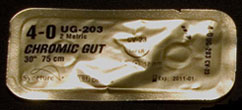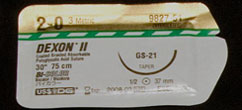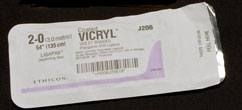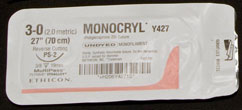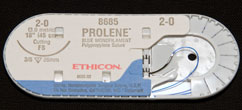- wide variety of sutures materials and brands available
- need to be familiar with the important characteristics of the ones you use
- a small sample of some classic and commonly used materials are detailed to demonstrate important considerations in selection - the list is by no means exhaustive
For each suture that you use, you need to know:
- absorbable or nonabsorbable
- if absorbable, how rapidly
- monofilament or multifilament (braided)
- amount of tissue reaction that it stimulates
- knot security and ease of handling
- unique properties of that material
Rapidly absorbable
(significant loss of tensile strength by 14 days)
Chromic Gut
- derived from sheep intestinal submucosa and bovine intestinal serosa
- treated with formaldehyde
- chromic Gut: treated with chromic salt
- increases strength
- slow loss of tensile strength
- decreases tissue reaction
- absorbed by phagocytosis
- rapidly absorbable
- loses tensile strength (33% in 7 days, 67% in 28 days)
- complete removal from tissue prolonged (can be found encapsulated at previous sites years later)
- rapid premature loss of strength in infected wounds, after exposure to digestive enzymes (eg. stomach), in highly vascular tissue, and protein-depleted patients
- causes significant foreign body reaction
- relatively good handling characteristics
- stiff in larger sizes
- good knot security
- minimum of 3 throws are recommended for a secure knot
- four throws for starting knot and five throws for ending knot on continuous patterns
- ends need to be left 3-5 mm long as tend to untie when wet
- should NOT be used to close the abdominal wall because of rapid, unpredictable loss of strength
- economical
- use largely been replaced by synthetic materials
characteristics summary
- natural
- rapidly absorbable
- multifilament
- reactive in tissue
Polyglycolic acid (Dexon)
- made of a glycolic acid polymer
- absorbed by hydrolysis
- rapidly absorbable
- most of its tensile strength lost within 2 weeks of implantation
- removed from the body within 3-4 months
- more rapid absorption in alkaline environment (eg. urinary bladder)
- significant tissue drag
- may cut delicate tissues
- available with coating
- decreases drag
- poorer knot security (need extra throws)
- comparison with chromic gut:
- stronger
- more predictable strength loss
- less reactive
- more rapid and complete removal from body
- can be used to close clean tissue layers that regain sufficient strength within 7-10 days
Characteristics summary
- synthetic
- rapidly absorbable
- braided multifilament
Polyglactin 910 (Vicryl)
- composed of copolymer of glycolide and epsilon-caprolactone
- rapidly absorbable by hydrolysis
- loses tensile strength quickly (50 % within 7 days)
- completely removed from body within 4 months
- initially very strong (strongest of absorbable)
- initial strength allows selection of 1-2 sizes smaller than would normally
- minimal tissue reaction
- soft, pliable material with excellent handling
- minimal tissue drag
- good knot security
- required throws for secure knot formation is unknown (follow those for polydioxanone)
- 4 throws for a secure knot
- 5 throws at the start and 6-7 at end of continuous pattern
- used for soft tissue suturing when prolonged wound support is not necessary (eg. subcutaneous and intradermal layers)
Characteristics summary
- synthetic
- rapidly absorbable
- braided multifilament

Poliglecaprone 25 (Monocryl)
- composed of copolymer of glycolide and epsilon-caprolactone
- rapidly absorbable by hydrolysis
- loses tensile strength quickly (50 % within 7 days)
- completely removed from body within 4 months
- initially very strong (strongest of absorbable)
- initial strength allows selection of 1-2 sizes smaller than would normally
- minimal tissue reaction
- soft, pliable material with excellent handling
- minimal tissue drag
- good knot security
- required throws for secure knot formation is unknown (follow those for polydioxanone)
- 4 throws for a secure knot
- 5 throws at the start and 6-7 at end of continuous pattern
- used for soft tissue suturing when prolonged wound support is not necessary (eg. subcutaneous and intradermal layers)
Characteristics summary
- synthetic
- rapidly absorbable
- monofilament
- strong
- minimally reactive

Slowly absorbable
(significant strength remains for at least 30 days but lost by 60 days)
Polydioxanone (PDS II)
- composed of paradioxanone polymers
- absorbed by hydrolysis
- slowly absorbable
- over 50% strength remains after 6 weeks
- complete removal from the body up to 6 months
- strength maintained in alkaline environment (suitable to close urinary bladder)
- strong
- minimal tissue reaction
- acceptable handling qualities but larger sizes are stiff
- minimal tissue drag
- reasonable knot security
- 4 throws for secure knot
- 5 throws at start and 6-7 at end of continuous pattern
- popular choice for general soft tissue suturing
- recommended when prolonged tissue support desired.
Characteristics summary
- synthetic
- slowly absorbable
- monofilament
- strong
- minimally reactive
Polyglyconate (Maxon)
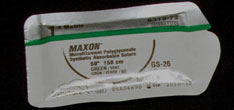
- composed of glycolic acid and trimethylene carbonate
- absorbed by hydrolysis
- slowly absorbable
- 50% tensile strength lost by 3 weeks
- complete absorption takes 6-7 months
- retains strength in alkaline environment (can use for urinary bladder closure)
- strength similar to polydioxanone
- minimal tissue drag
- stiff
- tends to conform tissues to suture rather than conforming to tissues
- good knot security when extra throws placed
- 4 throws for secure knot 5 throws at start and 6-7 at end of continuous pattern
- more economical than PDS
- handling characteristics have limited use in small animals but could be selected for most soft tissue suturing
Characteristics summary
- synthetic
- slowly absorbable
- monofilament
- strong
- minimally reactive

Nonabsorbable
Silk

- derived from silkworm cocoon
- technically nonabsorbable
- slowly loses tensile strength over 6 months
- may be completely absorbed after 2 years
- not recommended if prolonged strength or persistence is desired (e.g. securing a prosthetic device)
- induces significant tissue reaction
- excellent handling characteristics
- good knot security
- economical
- should NOT use in infected or contaminated areas
- potentiates infection (less bacteria required to induce infection)
- harbor bacteria within braid leading to persistent infection
- uncommonly used
- use largely replaced by synthetic monofilament materials
Characteristics summary
- natural
- nonabsorbable (absorbed over several years)
- multifilament
- reactive

Polymerized caprolactum (supramid)
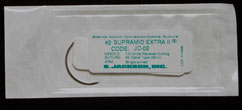
- composed of synthetic twisted multifilament polyamide encased in a smooth sheath
- very strong
- somewhat stiff to handle
- reactive when used in skin (increased if casing breaks)
- should NOT be buried because of high rate of draining tract formation
- economical
- primarily used as a skin suture in food animals
Characteristics summary
- synthetic
- nonabsorbable
- multifilament
- coated
- very reactive

Polyesters (Mersilene, Ethibond)
- composed of synthetic multifilament polyester
- very strong
- retains tensile strength when implanted
- significant tissue drag
- coating improves but decreases knot security
- moderate tissue reaction when implanted
- contraindicated in infected or contaminated wounds
- potentiates infection
- bacteria reside within braid leading to persistence of infection and chronic draining tracts
- primarily used for tendon and ligament repairs because of excellent strength
- eg. extracapsular cruciate repairs
- results in significant incidence of chronic draining tracts
- use gradually being replaced by monofilament options
Characteristics summary
- synthetic
- nonabsorbable
- multifilament
- strong
Nylon (Dermalon or Ethilon)
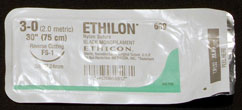
- available as both monofilament or multifilament
- composed of a polyamine
- monofilament form (Ethilon)
- inert
- minimal tissue reaction
- nonabsorbable by definition but loses 30% of strength within 2 years of implantation
- multifilament form (Dermalon)
- essentially no strength after 6 months
- somewhat stiff to handle
- uncommonly used
- significant memory, especially in larger sizes
- knot security is relatively poor so care necessary to ensure secure knots
- 4 throws required for a secure square knot
- additional throws necessary for continuous patterns (5 on beginning knot and 6 on ending knot)
- suture ends may be sharp so avoid in areas where could cause trauma
- mainly used as a skin suture, but can be buried if necessary
Characteristics summary
- synthetic
- nonabsorbable but strength loss over time
- minimally reactive
- available as monofilament or multifilament
Polybutester (Novafil)
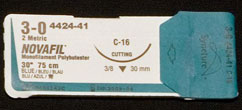
- composed of a copolymer of polyglycol and polybutylene terephthalates
- good tensile strength
- strength maintained when implanted
- slippery to handle
- more flexible and elastic than polypropylene or nylon
- minimal tissue reaction
- reasonable knot security but need to ensure throws adequately tightened
- nice handling qualities once experience gained with knots
- mainly used as a skin suture, but can be buried if necessary
Characteristics summary
- synthetic
- nonabsorbable
- monofilament
- minimally reactive

Polypropylene (Prolene)
- composed of a propylene polymer derived from propane gas
- not as strong as nylon
- retains initial strength when implanted
- minimal tissue drag
- minimal tissue reaction
- best knot security of synthetic monofilaments
- very nice handling qualities once experience gained with knots
- least likely of the monofilament nonabsorbable sutures to potentiate infection or induce thrombi
- used as skin suture and if need to permanently implant suture (eg. prosthetic device)
Characteristics summary
- synthetic
- nonabsorbable
- monofilament
- least reactive of sutures

Summary Charts
Table 1: Summary of Characteristics of Commonly used suture materials
Absorbable |
Mono vs. multi filament
|
Loss of tensile strength
|
Complete absorption
|
Tissue reactivity
|
# throws for secure knot (interrupted)
|
| Chromic gut |
Multi
|
Rapid (67% by 28 days)
|
60 days? (can be prolonged)
|
significant
|
3-4 (knots may loosen when wet)
|
| Polyglycolic acid (coated Dexon) |
Multi
|
Rapid (most by 2 weeks)
|
90-120 days
|
mild
|
4
|
| Polyglactin 910 (coated Vicryl) |
Multi
|
Rapid (most by 3 weeks)
|
60-90 days
|
mild
|
4
|
| Poliglecaprone 25 (Monocryl) |
Mono
|
Rapid (50% by 1 week, 80% by 2 weeks)
|
120 days
|
mild
|
4
|
| Polyglyconate (Maxon) |
Mono
|
Slow(45% by 3 weeks)
|
180 days
|
mild
|
4
|
| Polydioxanone (PDS II) |
Mono
|
Slow (31% by 6 weeks)
|
180 days
|
mild
|
4
|
Table 2: Summary of Characteristics of Commonly used suture materials
Nonabsorbable |
Mono vs. multi filament
|
Loss of tensile strength
|
Tissue reactivity
|
# throws for secure knot (interrupted)**
|
| Silk |
Multi
|
30% at 14 days, 50% at 1 year
|
significant
|
4
|
| Polymerized caprolactum (Supramid) |
Multi
|
Negligible
|
significant
|
4
|
| Polyesters (Mersilene, Ethibond) |
Multi
|
Negligible
|
significant
|
4-5
|
| Nylon (Ethilon, Dermalon) |
Mono
|
30% at 2 years
|
mild
|
4
|
| Nylon (Nurolon, Surgilon) |
Multi
|
80% at 180 days
|
mild
|
4
|
| Polybutester (novafil) |
Mono
|
Negligible
|
mild
|
4
|
| Polypropylene (Prolene) |
Mono
|
Negligible
|
mild
|
3-4
|
** At least 4 throws recommended for all nonabsorbable materials. For continuous patterns, add one additional throw for the beginning knot and 2 additional throws for the ending knot.
Information from a suture pack
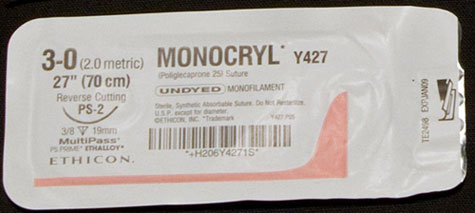
See Answer (PDF)


